In this area we present our blog posts on a variety of Viking subjects from a variety of authors. Please scroll down or use the filter to look at specific subjects…
Explore our blog posts...
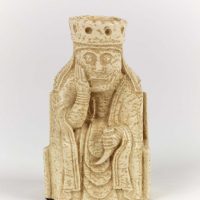
Viking Board Games
Jarl Rögnvaldr Kali Kolsson of Orkney composed a poem describing his nine skills in the first half of the twelfth century. These were all the skills that a member of the aristocracy in medieval Orkney and Scandinavia would have been expected to know, to be considered cultured and socially adept. Among these skills, he included board games (Old Norse tafl). It is possible that he meant chess, because chess was becoming fashionable in the courts of Europe at this time. However, Rögnvaldr could have been referring to any number of board games: Old Norse tafl refers to board games in general, rather than to one specific one. It is related to the Latin word tabula and the modern English word 'table'. In its most general sense it refers to a flat surface, hence the board of a board game. The Old Norse word tafl is occasionally compounded with other words to specify more closely which game is meant; for example, Old Norse skáktafl means chess. Rögnvaldr lived shortly after the end of the Viking Age, but it is highly likely that the Vikings considered knowledge of these games to be an important part of a man’s social skills, as is suggested by episodes where they are depicted playing board games in the sagas, and the cultural context in which board games were played as recreation remained substantially the same from the Viking Age into the medieval period. Hnefatafl (often called 'King’s Table' in English) is the board game most commonly associated with the Viking Age by modern people. It can be traced back to games played in Imperial Rome from at least the first century AD under the name Ludus latrunculorum (the game of the little thieves). These games were made popular throughout Europe under the Roman Empire. They were only replaced when chess arrived in Europe from India. Hnefatafl is an asymmetric game where the defender has to try to move their king off the board while the attacker has to capture the king. Moves are made orthogonally in the same manner as a rook in chess. There are many variants of this game, using different sized grids but all have an odd number of rows so that the king may be placed in the central square. There are no detailed descriptions in Scandinavian sources that permit reconstruction of the rules. Instead the rules used now have been developed from the rules for Tablut which Carl Linnaeus wrote down in Latin in 1732. Linnaeus’ description of the game was based on his observations of how it was played among the Sámi. It is fortunate that he chose to visit the Sámi when he did, because Tablut was becoming less popular at that time; the younger people preferred card games to board games. There are gaps in the rules that Linnaeus recorded, and modern rules have been adapted to fill those gaps, and to balance the game. This has resulted in a number of variants of hnefatafl in use today. Hnefatafl is attested in written sources that are supported by archaeological evidence. Ragnars saga loðbrókar mentions that Sigurðr and Hvítserkr played it, and in Morkinskinna, one of the histories of the Norwegian kings, Sigurðr Jerusalem-farer, king of Norway from 1103-1130, boasts how much stronger he is than other men, but his brother Eysteinn immediately puts him down by saying “Yes, but I’m better at hnefatafl than you!” Gull-Þóris saga mentions that two women played hnefatafl, so it was obviously socially acceptable for women to play too. Of course, while hnefatafl was a pastime, it did not always end well. Þorbjörn Hook was playing halatafl, a variant of hnefatafl that used pieces with pegs in the base that could then be inserted into holes in the board, thus making it a perfect travel game. His stepmother thought this was not a good use of his time, so she grabbed one of the pieces and threw it in his face, gouging his eye out in the process so that it hung down on his cheek. There is ample physical evidence for these games. Game boards of a type that Rögnvaldr would have known have been found in Viking Age boat burials like the Gokstad ship (c. 900) where a double-sided board was found. On one side it has a grid that may have been for hnefatafl while on the other is a grid for Nine Men’s Morris, another ancient game that was probably popularised throughout Europe under the Roman Empire. A fifteen by fifteen gridded board was found in the Coppergate excavations in Viking Age York, pointing to a variant of hnefatafl being played there. The Ballinderry gaming board with its drilled peg holes may be a board for a halatafl variant. The literary evidence also suggests that the defender's pieces were usually red, while the attackers were white, although archaeological finds suggest a broader range of colours. Dozens of playing pieces from Viking board games have been found on archaeological sites, including the Viking camps at Repton and Torksey in England, where invading Vikings presumably whiled away their time playing these board games. Some of these were on display in the Danelaw Saga exhibition at the University of Nottingham. The Portable Antiquities Scheme has also recorded a broad spread of gaming pieces throughout the Danelaw. These pieces are usually roughly conical in shape and could have been cast very quickly and easily in simple moulds. Gaming pieces could be made of glass, like some found at Birka in Sweden, amber, liked those from the Skamby ship burial, or of horn or antler. Some of the Lewis chess pieces may actually have served double function as tafl pieces too. Analysis of gaming pieces and their deposition in graves suggests that each person was not buried with enough gaming pieces to provide both sides in a tafl game. Instead, they could provide a force for the attacker on an 11x11 board, on average, or the defender on a board as large as 15x15 squares. This suggests that Vikings brought their own force to the table rather than one person providing both sides. One final piece of evidence for board gaming is the depiction of two people playing a game and drinking horns of ale on a runestone (Gs 19) at Ockelbo in Sweden. The original stone has been destroyed but a replica stands on the spot now and shows clearly that the game board had the centre and the four corners marked to show where the hnefi or king stood at the start and where he had to escape to. Sore losers So, how did these games go down at parties? Óláfs saga helga (Chapters 152-53) in Heimskringla (pdf link) relates the tale of how one game played out at a feast at Roskilde in Denmark. Knútr the Great, king of England and Denmark, and he who tried to turn back the waves, was asked by his brother-in-law if he would like to play a board game. Knútr accepted but played badly. He was in a foul mood anyway, and got into a worse mood when Úlfr checked one of his pieces. He took his piece back, saying that he would make a different move instead. Úlfr got angry and tipped the board over, before storming out after they exchanged insults. The next morning, Knútr was getting dressed when he told his servant boy to go and kill Úlfr. The boy returned saying that Úlfr was in the church so he could not do it. Next Knútr told a Norwegian called Ívarr to kill Úlfr. Ivarr went into the church and ran Úlfr through with his sword. He returned to Knútr and told him the news. Heimskringla tells us that Knútr said to Ívarr “You have done well” but I prefer to imagine Knútr saying instead, “Checkmate!” If you are interested in trying hnefatafl cheaply, Cyningstan has a number of print-and-play hnefatafl variants.
Read More
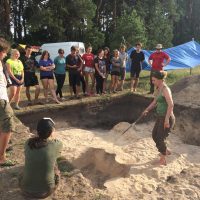
Vypovziv: A Viking Age outpost in Ukraine
In July 2018 a group of University of Nottingham students from the School of English went on an archaeological expedition to Vypovziv, Ukraine. The group was led by Dr Cat Jarman from the University of Bristol whose work on Viking camps at Repton has yielded spectacular results. As a result, Dr Jarman’s work with the Repton winter camp is particularly relevant to the project and allows sites such as Vypovziv to be compared more easily with its English counterparts. The village of Vypovziv is located two hours north of Chernihiv and is the site of a Viking Age Rus outpost. The outpost served as a control point along the Desna river route as well as a toll/re-supply station for travellers and merchants coming along the river to or from Kyiv during the later 9th through to the late 10th century. The Viking outpost is located on top of a tall ridge that stands out in the low marshy landscape and would have bisected the Desna River. The site included a fortified area with a palisade and a surrounding open settlement. The site included a fortified area with a palisade and a surrounding open settlement. Vypovziv, and sites like it, shares many similarities such as layout, location, and types of artefacts to winter camps in England such as Torksey and Repton, where Dr Cat Jarman is currently conducting archaeological fieldwork. Vypovziv, Repton, and Torksey all had some form of defence to protect them, were located in naturally strategic positions near rivers which provided easy access by boat, and at one stage in their lifespan became administrative and/or commercial centres. All three sites had a mixture of inhabitants, including women and children, and were specifically created by Scandinavian immigrants. The main difference between them is the initial motivation for their founding, Vypovziv was established as a point of control along a trade route while sites such as Repton and Torksey began life as a base for the Great Viking Army invading England. The Nottingham team were given a previously unexcavated section within the boundaries of what would have been the settlement area of the outpost just down the ridge from the fortified area. The artefacts found ranged in date from the late 9th century to the 12th century and included tools such as needles and awls, imported and local glass beads, imported jewellery, and various pieces of pottery, one making its way from the Byzantine Empire. The last day produced perhaps the most interesting finds, two ovens demarcating two separate dwellings. The team looks forward to returning next July to continue their exciting work. The expedition was made possible by funding secured by William Pidzamecky through the Cascade Grants Programme. The group joined the archaeological team from the University of Chernihiv, led by Dr Vyacheslav Skorohod, which has been excavating at the site for over a decade.
Read More
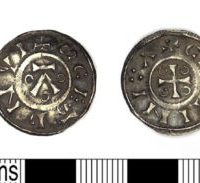
Anglo-Viking Coinage and other currency used by Scandinavians in Leicestershire
Working in a county that was part of the Danelaw and which had already revealed the small, but fabulously important Thurcaston hoard, found back in the 1990s (LEIC-C6D945), I was a little disappointed that in 13 years as a Finds Liaison Officer, I had only recorded one ‘Anglo-Viking’ coin. This was a ‘Cunnetti’ issue (895-902) of York, found in 2009 in Rearsby Parish (LEIC-B230B). Everything changed in late in 2015 when I was shown a St Edmund memorial penny. These were minted in East Anglia by its Scandinavian rulers c. 895-910 AD. The coins feature the often blundered inscription ‘SC EDMUND’, a dedication to the saint who was, ironically, martyred by ‘Vikings’. I told the finder how rare his coin was and that he had made my year (see LEIC-19C0DA ). However, it seems that these coins are like buses and within weeks I was shown another (LEIC-B7F405). By April 2016 we had the hat trick, with a third being found in the same district as the first, all in North Leicestershire ( LEIC-4FC58C). A further two examples of this coin had been found prior to the inception of the Portable Antiquities Scheme. The first and the only ‘Anglo-Viking’ coin recorded for Leicestershire on the Early Medieval Corpus (EMC - managed by the Fitzwilliam Museum who also care for the Thurcaston hoard) was found near Wymeswold in 1987 (EMC 1987: 118). The only one found in the county so far by excavation turned up during the major ‘Shires’ excavation in Leicester city centre in 1988 (A39.1988). This alone is a very important find. As an ‘Anglo- Viking’ coin lost in an urban environment, it suggests that Scandinavian traders were present or, at least, that a Scandinavian lost a coin they were hoping to use as currency there. The St Edmund coins are very interesting for a number of reasons: firstly, they are not 'legal' tender in England, so must have been circulating amongst Scandinavian settlers. Because of this their distribution may tell us something about the locations of such settlers and also which areas were Scandinavian enough to be producing these coins. We don’t yet know for certain where these coins were minted. The majority were lost (unsurprisingly) within East Anglia, so judging by their find spots, were minted in Bury St Edmunds (also named after the saint). There are also examples now turning up in the East Midlands and the south east. The numismatist Dr. Mark Blackburn thought that some were also minted in the East Midlands, as the coins vary slightly in design. Given their distribution Leicester, Derby or Nottingham are possibilities. Nationally the PAS has recorded 37 (as of Sept 2018) and EMC has 95 (end 2017). Most were single finds from within the Danelaw, with the most northerly outlier being one in a hoard in Cumbria, and a few were found just outside the Danelaw in Oxfordshire and Staffordshire. In addition to this ‘Anglo-Viking’ coinage, other forms of currency were circulating. The Scandinavians practised what we call a ‘mixed’ or ‘bullion’ economy where coins were valued for their weight in silver as well as their face value and ‘hacksilver’- cut up artefacts or chunks of bullion were also used as currency by weight. This is why the Thurcaston hoard is important as it contains Anglo-Saxon, ‘Viking’ York and Arabic coin issues. The latter two were not legal currency, so could have only circulated as ‘bullion’. The hoard dates to 923-5 so it’s also good evidence for a mixed economy still being used by the local population at a time when the Danelaw was supposedly back under Anglo-Saxon control. In Leicestershire we have a few examples of this economy, most notably two ‘cigar’ shaped silver ingots which were found near Breedon on the Hill (DENO-34FB88 DENO-CE6103) and which featured in the Danelaw Saga exhibition. Nationally the PAS has recorded 163 of these ingots (136 are silver) with the largest concentrations coming from Lincolnshire, Norfolk, Suffolk, Yorkshire and Cumbria. We have evidence for other foreign coinage probably used as bullion. We have a silver Denier of Charles the Bald, Carolingian King of the West Franks, c.840-877, from Grimston, Melton (LEIC-9F7227). Only 8 of these have been recorded by the PAS nationally and they are thought to have circulated in fairly large numbers in eastern England in 9th and 10th century as a result of the Scandinavian presence. Even rarer is a copper alloy coin of Umayyad Syria, probably minted in Damascus and dating to the 8th century. This was found in a garden in Loughborough (LEIC-94D4D2). It’s just possible that such a coin was lost by a passing Scandinavian. We also have a rare example of ‘pecking’ -a practice of testing the purity of silver by inserting a knife blade into a coins surface. A penny of Aethelred II from Syston (LEIC-01EB53) has been pecked all over both surfaces, suggesting it went through several ’Viking’ hands who wanted to check for themselves that the coin was indeed pure silver. This currency, in its many forms, adds an important layer of evidence in a county that was in the Danelaw, but which has not yet yielded too much solid evidence for Scandinavian settlers. They add much weight to the counties few artefacts and many place-names that reflect an Anglo-Scandinavian character, but whose reliability as evidence for settlers is hotly debated. These issues were only used in Leicestershire by people who accepted them, either for their bullion value or because they were Scandinavian issues. So unless the illegal use of non-English currency was rife in the East Midlands, this currency points to a Scandinavian population. For more information on Anglo-Viking coins see: www.finds.org.uk www.emc.fitzmuseum.cam.ac.uk Blackburn, M.A.S. Viking coinage and currency in the British Isles, Spink 2011.
Read More
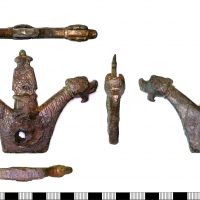
Blazing Saddles? Saddles in the Viking Age (Part 2)
This is part 2 of a blog post on Viking Age riding equipment. You can read Part 1 HERE. Viking saddles develop from the 4th century AD, with Eurasian influences very obvious, and there’s a bit of Roman influence there too, but when you think of the great war booty deposits of the Roman Iron Age in that region, that is very much to be expected. Typically, the saddles have high pommels, and occasionally high padded cantles to create a very secure and comfortable seat, although we are still uncertain about some aspects of their construction and use. Often there are gullets and pommel horns not unlike a modern Western saddle, enhancing the comfort aspect for the long distance rider. When we consider the pacing animals in Nordic equitation, and the glorious flying tölt they execute, then this makes a lot of sense. The pace of these ponies eats the miles up with maximum comfort. You would not want to spend an entire day cross-country hacking in a flat dressage saddle as you’d be very 'Thor' at the end it all ( sorry). It has to be noted that it is very difficult to knock someone out of one of these saddles. Saddles have been found in burials around Scandinavia in various states of preservation, sadly none of them ultimately satisfying to the archaeological mind, but I have to say I’ve been quite taken with the reconstructions by Carlstein (2014) to fill in the gaps of Vendel (and as a result Viking) saddlery. Examples have been found at Vallstenarum, in Gotland, and also in the Valsgärde 7 burial (see Fig. 4), both Vendelic, but there is such a huge continuity of style, the chronological devil appears to be in the details. These saddles were decorated with metal mounts on both pommel and cantle (Lindgren 2017; Carlstein 2014; Arwidsson 1977). The most complete example is the Oseberg saddle, which dates between AD 800 -900 (Bonde and Christansen 1993). It is made of beechwood, and in the absence of the padding it would have had around it, stud marks are visible, which may well suggest it too would have had decoration of some kind. Likewise with the frame of a saddle found at Fishamble Street in Dublin (Kavanagh 1988). Bling was commonplace on Viking equestrian equipment, making the ordinary workaday object into something very beautiful. Many of the decorative mounts which share commonalities of design may well mark out specialist workshops, sought out because they created things of power and beauty. Back for a moment to the Vendel saddles of the 7th century AD at Vallstenarum in Sweden; it is notable because of its finely worked hawk or falcon decorative mounts. These little objects, now on display in the Statens Historika Museet in Stockholm are just under 8 cm in length, very close indeed to the length (7.4 cm) of the Leicestershire piece. On their reverse side, the bird of prey mounts of the Vallstenarum saddle have dents and marks indicating that they were attached by small rivets and pins in a manner similar to our UK mystery piece. This ‘pinning’ is noted by Akhmedov (2018, 518) in his discussion on the fantastical little creatures and human features which decorated equestrian equipment during the early medieval period in northwestern Europe and Scandinavia (Akhmedov 2018, 520). If we are to go purely on the indentations and places where rivets have connected it to something, it would seem fairly plausible that this was perhaps one of a pair of very fine saddle decorations. A caveat must be emphasised again that the mount could be from clothing, jewellery, a box holding precious things – there are a host of possibilities. I think one of the areas I would want to examine would be the off-centre, very raw perforation in the piece. It appears to be from being placed on something which had stretched or altered shape slightly in use, which also may point towards saddlery. The tree of saddles are wood and the padding leathers and fibre, and these stretch with time and regular, repetitive use. It is why horsie folks tend to check their saddles on a fairly regular basis. We do not have pretty gold and copper alloy decorations anymore (more's the pity) but if we did, and the saddle was worn, the perforation of a softish metal would warp slightly, showing how we were riding – straight or lopsided. An analysis of use-wear, and direction of ‘tug’ may provide some interesting information. Likewise with the metal itself, a quick, non-invasive analysis via pXRF would indicate the nature of the alloy. The symbolism of the creatures and the little manikin with the staring eyes no doubt have their own story to tell (Nordqvist 2013), which I would feel safer being left in the hands of Viking specialists, but for now, this little object offers a potential insight into someone’s unique tastes and preferences in decorating for power and success. Akhmedov, I. 2018. ‘Matrices from the Collection of K.I. Ol’shevskij. The North Caucasian group of Early Medieval imprinted decorations’ in Nagy, M and Szőlősi, K (eds) To make a fairy’s whistle from a briar rose” Studies presented to Eszter Istvánovits on her sixtieth birthday. Nyíregyháza: Jósa András Múzeum 505-527 Arwidsson, G. 1977. Valsgärd 7 AMAS ( Die graberfund von Valsgarde 3) Uppsala Bersu, G. and Wilson, D.M. 1966. Three Viking graves in the Isle of Man (No. 1). Society for Medieval Archaeology. Bonde, N. and Christensen, A.E., 1993. ‘Dendrochronological dating of the Viking Age ship burials at Oseberg, Gokstad and Tune, Norway’. Antiquity. 67. 256. 575-583. Carlstein, C. 2014. Krigarens säte i striden? En kvantitativ studie av beslag och ringar tillhörande den Sydskandinaviska ringsadeln, med utgångspunkt i fynden från krigsbytesofferplatsen i Finnestorp. Unpubished dissertation. Göteborgs Universitet Geake, H. 2005 Medieval Archaeology 49, Available at: http://archaeologydataservice.ac.uk/archiveDS/archiveDownload?t=arch-769-1/dissemination/pdf/vol49/49_323_473_med_britain.pdf Kavanagh, R., 1988. ‘The horse in Viking Ireland’ in Bradley, J and Martin F.X (eds) Settlement and society in medieval Ireland. Boethius Press, Kilkenny. 89-121. Lindgren, S. 2017 Glimmande artefakter och vendeltida social struktur – En studie av järnålderslandskapet i Vallstena socken på östra Gotland 7th century AD. Unpublished dissertation Uppsala University Nordqvist, B., 2013. ‘Symbols of identity: A phenomenon from the migration period based on an example from Finnestorp’ in Bergerbrant, S and Sabatini, S (eds.) Counterpoint: Essays in Archaeology and Heritage Studies in Honour of Professor Kristian Kristiansen Oxford :BAR S2508. 213-221. Pedersen, A. 1996-97. ‘ Riding gear from late Viking Denmark’ Journal of Danish Archaeology .13. 133-161 Wilde, W.R., 1861. A descriptive catalogue of the antiquities of animal materials and bronze in the museum of the Royal Irish Academy. Dublin: Hodges. Dr Rena Maguire recently completed her PhD at Queen's University Belfast. Her main research interests lie in Late Iron Age material culture studies, metals and horses.
Read More

Blazing Saddles? A mysterious Viking object from Leicestershire (Part 1)
Mystery objects are always fun things to debate in archaeology. When something appears to buck the trends of any known design or type, and displays something unseen before, it offers a chance to re-examine items stashed in storage in museums, and maybe most importantly, our own sometimes stodgy thoughts! My research speciality is equitation and equestrian equipment of late prehistory, as my doctoral thesis tried to make sense of Late Iron Age riders across northwest Europe. So many happy hours were spent buried in war booty tack from Denmark, Germany and the Baltic, piecing together the story of the horse in Ireland and Britain! More recently, I’ve been illustrating and cataloguing Viking-Irish bridle assemblages for Dr. B.G Scott, with particular attention to workshop variations on cheek pieces. So , with my horsie head on I have been dragged in to give my tuppence worth on the peculiar little mount recorded in the PAS scheme as LEIC-0A4CB4, and look at it from a very practical equestrian point of view, alongside an archaeological one. Found in the Hinckley and Bosworth region of Leicestershire, the small copper alloy and gold mount is described as having “ a rectangular base from which three projections rise. Two are in the shape of animal heads on long necks; each has a mane along the neck made up of grooves, a raised collar at the top of the neck, large circular eyes, and rounded ears decorated with a triquetra. Underneath the chin, each head has a beard-like protrusion. The heads are decorated in the round, but the mane appears on one face only. The central projection is decorated on one face only. At the base is the upper part of a human face, with relief eyes, eyebrows, nose and moustache. Above is grooved interlace decoration which appears to be in the Borre style” (Geake 2004, 334) Despite some past speculation that it may be part of a cheek piece for a bridle, the small attachments on the back (see Fig. 1) rule this theory out. A cheek-piece on the outside of a bit (not to be confused with the leather or fibre strapping which connects to the bit) fulfils the task of stopping a mouthpiece slipping in the horse’s mouth, making the bit ineffective as a means of control. As such, it needs to have certain features, such as a suitable aperture to feed the connecting strapping through to construct the actual bridle, and some evidence that it was large enough to integrate with the mouthpiece (see Fig. 2). The aperture on this little artefact is too raw, irregular and small to allow this, although it could, possibly be a decoration from somewhere else on the bridle, potentially the brow band. Based on finds from sites such as Balladoole, on the Isle of Man (Bersu and Wilson 1966), Navan, in Meath (Wilde 1861, 611) and some stuff found around Coleraine some time back, as well as the general archaeological record, I am inclined to feel that Scandinavian riders had rather good seats and rode well. Bridles tend to be functional, with straightforward single-jointed snaffles, rather than the bizarre and cruel bits often seen in the Roman world. Viking bits are often permutations on full cheek snaffles, and occasionally decorated with the exquisite dragonesque forms described by Pedersen (1996-97). Just because I think you’d like to see one up close and personal, I’ve shown in Fig. 3 a specimen from The Hunt Museum in Limerick from my own research – they are delightful things, but as you can see, rather substantial, well in excess of 11 cm in length. While the mysterious little Leicestershire object could be a decorative mount off anything, it does resemble the kind of decoration often present on Viking saddles. For more on Viking saddles, see Part 2 of this article. References: Bersu, G. and Wilson, D.M. 1966. Three Viking graves in the Isle of Man (No. 1). Society for Medieval Archaeology. Geake, H. 2005 Medieval Archaeology 49. Pedersen, A. 1996-97. ‘ Riding gear from late Viking Denmark’ Journal of Danish Archaeology 13. 133-161 Wilde, W.R., 1861. A descriptive catalogue of the antiquities of animal materials and bronze in the museum of the Royal Irish Academy. Dublin: Hodges. See Part 2 of this post HERE. Dr Rena Maguire recently completed her PhD at Queen's University Belfast. Her main research interests lie in Late Iron Age material culture studies, metals and horses.
Read More
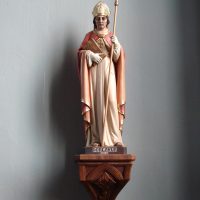
Saint Thorlak in Lincoln
The first Icelander known to have studied in Lincoln was Þorlákr (Thorlak) Þórhallsson, bishop of Skálholt, South Iceland, from 1178 until his death in 1193. He studied abroad from c. 1153 – 1159, first in Paris and then in Lincoln. The reason he went to Lincoln is unknown. He may have met a master in Paris whom he followed to England. Another good reason might be that the cathedral school of Lincoln was well known at that time for the study of canonical law. He must have enjoyed his stay in Lincoln because his nephew, Páll Jónsson, followed in his footsteps and studied there as well. All sources on Þorlákr are written in the vernacular (Old Icelandic) except for remnants of Latin texts written shortly after 1200. Three versions of Þorláks saga (The Saga of Thorlak) have been preserved. The oldest version of the Icelandic Þorláks saga was composed about the same time as the Latin texts. Þorláks saga describes the bishop as a pious man in a hagiographic fashion, but it also tells of his disputes with chieftains about church ownership and moral issues. To his dismay, one of the country's most powerful chieftains kept Þorlákr's sister as a concubine. Their son was the aforementioned Páll Jónsson who succeded Þorlákr as bishop of Skálholt. As bishop, he permitted people to invoke his uncle Þorlákr as a saint. Þorlákr's miracles were gathered and written down in a book, still preserved in a 13th-century manuscript. The original version of the miracle-book was read aloud at the Alþingi in Þingvellir, in 1199. Þorlákr seems to have been a popular saint until the reformation. Today, Icelanders mainly remember him because of his feast-day, December 23rd, the day when people are making their final preparations for Christmas. The day is still called Þorláksmessa, the Mass of St Þorlákr. The Viking Society for Northern Research has a freely downloadable pdf translation of The Saga of Bishop Thorlak (Þorláks saga byskups) if you wish to read more about him.
Read More
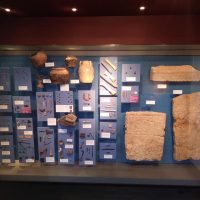
The Vikings in Lincoln
by Dr Erik Grigg, Learning Officer, The Collection, Lincoln The Collection in Lincoln has a fascinating Viking display, some of which were found nearby as it is located in the heart of an important Viking trading settlement. Even the local street names indicate Scandinavian origin and demonstrate the enduring influence of the Scandinavian settlers on the area: on one side of the museum is Danesgate which means 'Danish Street' (gata being the Old Norse for street). The use of Old Norse gata persists in other street names around The Collection: Flaxengate, meaning the street where people were turning flax into linen to make clothes, lies immediately to the west, while Michaelgate and Hungate are only a short walk away. ‘Gate’ has become the local word for ‘street’ thanks to the Scandinavian settlers in the Viking Age. The Vikings first turned up in the area in the 870s and the Great Heathen Army made camp at nearby Torksey. The museum has a small case of finds from the recent excavations there including pieces of gold and silver hacked into convenient bits to use as treasure or currency. After they established control, the Vikings soon settled down and turned the old Roman city of Lincoln into a vibrant trading borough. Coins and a coin die used to make them are on display in the museum as Lincoln was an important mint. The Vikings kept themselves clean and tidy and the museum has the reconstruction of a Viking comb-maker's workshop. The finest piece on display is an eleventh or twelfth century Urnes mount, a sumptuous piece of Viking metalwork with the typical motif of intertwined dragons. Carved grave covers, a sword, axe heads and bone ice skates are also found in The Collection as well as a recently discovered rare gold Thor's Hammer pendant. Dr Grigg has written more about the Viking Borough of Lincoln on the Visit Lincoln website.
Read More
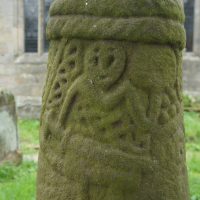
Some Derbyshire Warriors
Of the East Midlands counties, Derbyshire is perhaps the least well known for its Viking Age remains, apart of course from the camp at Repton. There is a scatter of place-names that suggest that members of that camp settled down in the region. And the recent publication of the Derbyshire volume of the Corpus of Anglo-Saxon Stone Sculpture provides further clues. At Brailsford, not far from Derby, a moss-covered cross-shaft stands outside the church, depicting a figure with a small shield and a rather large sword. The Corpus volume describes this as a 'battle-ready warrior' (p. 91) and suggests (p. 157) that this unusual warrior image is a memorial stone or marker of a member of the Anglo-Scandinavian warrior elite. The stone is loosely dated to the tenth century, so it could represent someone who had been at Repton, or more likely one of his descendants. Another warrior figure can be found on a cross-shaft at Norbury, to the west of Brailsford. This figure has a sword and what looks like a horn. The Corpus volume suggests (p. 194) that this is similarly a memorial to a member of the warrior elite. But it also raises the intriguing possibility that the figure represents the Norse god Heimdallr, whose horn announces the beginning of Ragnarök. While a bit speculative, this is not impossible since Heimdallr is fairly certainly represented on the Gosforth cross in Cumbria and possibly on the Jurby cross in the Isle of Man. Though there seem to be only two warrior-figures from Derbyshire, there are plenty of other Anglo-Scandinavian sculptures. There are (or were) two hogbacks: one from Repton which is lost but known from drawings, and one from Derby which can be seen in the museum there. There are a number of crosses and cross-shafts with various types of Viking Age ornament. Particularly interesting is part of a cross-shaft from Bakewell with Borre-style ring-chain (p. 122). This type of ornament is associated with the Irish Sea region and demonstrates the links the East Midlands had with the rest of the Viking world. Who all these memorials represent is a fascinating question we would all love to know the answer to. Most intriguing of all is a rune-inscribed fragment, also from Bakewell. The runes are very clearly Anglo-Saxon, yet as interpreted by David Parsons (p. 142) they most likely represent the Scandinavian male personal name Helgi (or its female equivalent Helga).
Read More
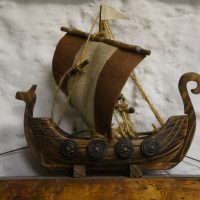
Bringing Vikings Back to the East Midlands
As this website is about to go live, it seems right to reflect on what has happened over the last year and a half and where we are going next. 2017 and 2018 were very busy with our 'Bringing Vikings Back to the East Midlands'. It all started when the University Museum heard that it would be one of the venues for the British Museum travelling exhibition Viking: Rediscover the Legend. We began making some preparations for associated activities, and were lucky enough to get a substantial grant from the Arts and Humanities Research Council to support these activities. We were even luckier that Dr Roderick Dale, formerly of the World-Tree Project at University College, Cork, was available to take on the post of Cultural Engagement Officer and to manage these activities. We then started thinking bigger and planned, and got funding for, a second exhibition, Danelaw Saga, and a popular book on Viking Nottinghamshire. You can read about all of these things in more detail on our About the Project page. One important aspect of that project was to fix some of what was achieved then for the future, hence this site, which we think of as a virtual museum. Here, you will be able to catch up on some of the talks that you might have missed during the exhibitions. You will also be able to see many of the items featured in the Danelaw Saga exhibition, with more information about where to go to see them in museums, or on the Portable Antiquities scheme website. A strong feature of our exhibition-related activities were the handling sessions with museum-quality reproductions of Viking Age artefacts made especially for us by Adam Parsons of Blueaxe Reproductions - we now have high-quality photos of these for you to download and marvel at how the objects would have looked when they were new. A further exciting feature are the Viking designs made for us by Adam - these are line drawings which you can use for whatever educational or entrepreneurial purpose you might have. They are open-access and available to use under Creative Commons CC-BY-4.0. Other features of this museum, such as the place- and personal names and runes are still in development, so keep coming back to find something new. Although the original project is now officially over, Roderick is still with us for phase 2. He will keep working on this site during the coming year, alongside some other duties, so bear with us as we keep making it better and more detailed. Do explore this virtual museum and let us know what you think on our Twitter account @emidsvikings.
Read More
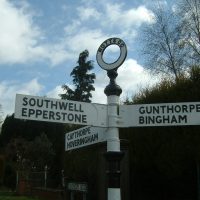
The East Midlands in the Viking Age
Vikings in the East Midlands is a brand-new virtual museum highlighting a number of aspects of the Viking heritage of the East Midlands. It is part of a larger project funded by the Arts and Humanities Research Council and the British Identities Research Priority Area of the University of Nottingham. The larger project (Bringing Vikings Back to the East Midlands) included two exhibitions and a variety of other activities. In our museum you will find a record of some of those activities, such as the talks given by leading Viking experts. The main aim of this virtual museum is to present some of the most important evidence for the Viking Age in the East Midlands, focusing in particular on artefacts and names. As well as original artefacts, we also present modern reproductions of those artefacts to give an idea of what they would have looked like when new. You will also find designs based on those artefacts which can be used for creative, educational and entrepreneurial purposes under a Creative Commons license. We also highlight the place-names of the region, which are some of the most important evidence for the Viking impact, and the Scandinavian personal names introduced by the Viking settlers. Finally, we introduce the Viking Age uses of the runic alphabet. Although we go live on the 1st August 2018, this virtual museum is by no means complete, but there should be more than enough here for you to browse and find items of interest. We will continue adding material throughout the coming year. If you would like to contact us, the best way is through our Twitter account @emidsvikings.
